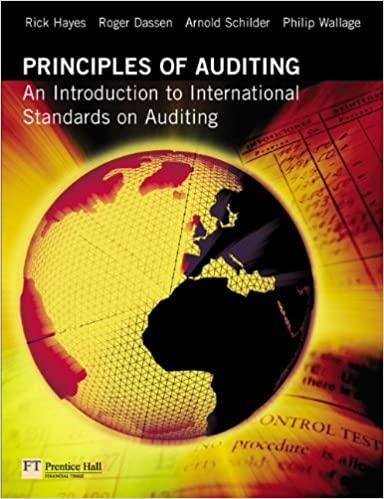Question
Samantha is a single individual with no dependents. In 2018, she had total income of $162,000, of which $9,500 is from municipal bond interest. She
Samantha is a single individual with no dependents. In 2018, she had total income of $162,000, of which $9,500 is from municipal bond interest. She has FOR AGI deductions of $12,000, itemized deductions of $9,800 and tax credits of $1,200. She also made estimated tax payments of $25,000. (Hint: Refer to the tax formula for individuals in Helpful Formulas from the Book PDF.)
- Compute Samanthas taxable income for 2018.
- Compute Samanthas tax due for 2018.
- Assume that Samantha is a C Corporation instead of an individual and all of the deductions are business related. What would the corporations tax due be for 2018?
3) Goliath Supplies Inc. (a C Corp) reports total net income of $575,000 in 2018. This includes $25,000 of income from 5.00% Jackson County municipal bonds (muni bond interest is not taxable). Thus, the Corporations taxable income is equal to $550,000.
- What is Goliaths tax liability for 2018?
- What are Goliaths marginal, average and effective tax rates, respectively?
- If equivalent taxablebonds pay 6.50% interest, what is the implicit tax rate for the Jackson County bonds? (see handout for Implicit Tax Rate)
- Did Goliath make a good choice to invest in the municipal bonds instead of the taxable bonds?
4) Joe owns a 25% interest in an S Corporation that earned $250,000 in 2018. He also owns 20% of the stock in a C Corporation that earned $400,000 during the year. The S Corporation distributed $50,000 to Joe, and the C Corporation paid dividends of $15,000 to Joe. How much income must Joe report from these businesses on his individual income tax return? (Hint: A C Corporation is a separate taxable entity. An S Corporation is a flow-through entity.)
5) Complete the following table by selecting a response in each box:
| Questions | General Partnership | S Corporation | C Corporation |
|
Who pays tax on the entitys income? |
Partners or the Partnership |
Shareholders or the Corporation |
Shareholders or the Corporation |
| Are operating losses passed through to owners? |
Yes/No |
Yes/No |
Yes/No |
| Are capital gains/losses reported on owners tax returns as such? |
Yes/No |
Yes/No |
Yes/No |
| Are distributions of profits taxable to owners? |
Yes/No |
Yes/No |
Yes/No |
| Is the liability of owners limited? |
Yes/No |
Yes/No |
Yes/No |
6) Identify the probable justification (economic, social, equity, political, or simply administrative feasibility) for each of the following provisions of the tax law.
- A tax credit allowed for electricity produced from renewable resources
- A tax credit allowed for the purchase of a motor vehicle that operate on alternative energy sources (e.g., nonfossil fuels)
- Favorable treatment accorded to research and development expenditures
- The deduction allowed for contributions to qualified charitable organizations
- An election that allows certain corporations to avoid the corporate income tax and pass losses through to their shareholders
Step by Step Solution
There are 3 Steps involved in it
Step: 1

Get Instant Access to Expert-Tailored Solutions
See step-by-step solutions with expert insights and AI powered tools for academic success
Step: 2

Step: 3

Ace Your Homework with AI
Get the answers you need in no time with our AI-driven, step-by-step assistance
Get Started


